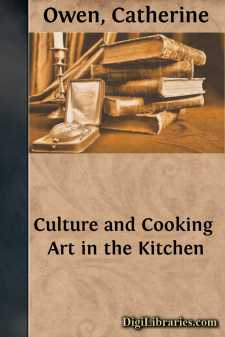Categories
- Antiques & Collectibles 13
- Architecture 36
- Art 48
- Bibles 22
- Biography & Autobiography 813
- Body, Mind & Spirit 141
- Business & Economics 28
- Children's Books 12
- Children's Fiction 9
- Computers 4
- Cooking 94
- Crafts & Hobbies 4
- Drama 346
- Education 46
- Family & Relationships 57
- Fiction 11826
- Games 19
- Gardening 17
- Health & Fitness 34
- History 1377
- House & Home 1
- Humor 147
- Juvenile Fiction 1873
- Juvenile Nonfiction 202
- Language Arts & Disciplines 88
- Law 16
- Literary Collections 686
- Literary Criticism 179
- Mathematics 13
- Medical 41
- Music 40
- Nature 179
- Non-Classifiable 1768
- Performing Arts 7
- Periodicals 1453
- Philosophy 64
- Photography 2
- Poetry 896
- Political Science 203
- Psychology 42
- Reference 154
- Religion 513
- Science 126
- Self-Help 83
- Social Science 81
- Sports & Recreation 34
- Study Aids 3
- Technology & Engineering 59
- Transportation 23
- Travel 463
- True Crime 29
Culture and Cooking Art in the Kitchen
by: Catherine Owen
Description:
Excerpt
a few preliminary remarks
Alexandre Dumas, père, after writing five hundred novels, says, "I wish to close my literary career with a book on cooking."
And in the hundred pages or so of preface—or perhaps overture would be the better word, since in it a group of literary men, while contributing recondite recipes, flourish trumpets in every key—to his huge volume he says, "I wish to be read by people of the world, and practiced by people of the art" (gens de l'art); and although I wish, like every one who writes, to be read by all the world, I wish to aid the practice, not of the professors of the culinary art, but those whose aspirations point to an enjoyment of the good things of life, but whose means of attaining them are limited.
There is a great deal of talk just now about cooking; in a lesser degree it takes its place as a popular topic with ceramics, modern antiques, and household art. The fact of it being in a mild way fashionable may do a little good to the eating world in general. And it may make it more easy to convince young women of refined proclivities that the art of cooking is not beneath their attention, to know that the Queen of England's daughters—and of course the cream of the London fair—have attended the lectures on the subject delivered at South Kensington, and that a young lady of rank, Sir James Coles's daughter, has been recording angel to the association, is in fact the R. C. C. who edits the "Official Handbook of Cookery."
But, notwithstanding all that has been done by South Kensington lectures in London and Miss Corson's Cooking School in New York to popularize the culinary art, one may go into a dozen houses, and find the ladies of the family with sticky fingers, scissors, and gum pot, busily porcelainizing clay jars, and not find one where they are as zealously trying to work out the problems of the "Official Handbook of Cookery."
I have nothing to say against the artistic distractions of the day. Anything that will induce love of the beautiful, and remove from us the possibility of a return to the horrors of hair-cloth and brocatel and crochet tidies, will be a stride in the right direction. But what I do protest against, is the fact, that the same refined girls and matrons, who so love to adorn their houses that they will spend hours improving a pickle jar, mediævalizing their furniture, or decorating the dinner service, will shirk everything that pertains to the preparation of food as dirty, disagreeable drudgery, and sit down to a commonplace, ill-prepared meal, served on those artistic plates, as complacently as if dainty food were not a refinement; as if heavy rolls and poor bread, burnt or greasy steak, and wilted potatoes did not smack of the shanty, just as loudly as coarse crockery or rag carpet—indeed far more so; the carpet and crockery may be due to poverty, but a dainty meal or its reverse will speak volumes for innate refinement or its lack in the woman who serves it. You see by my speaking of rag carpets and dainty meals in one breath, that I do not consider good things to be the privilege of the rich alone.
There are a great many dainty things the household of small or moderate means can have just as easily as the most wealthy....








